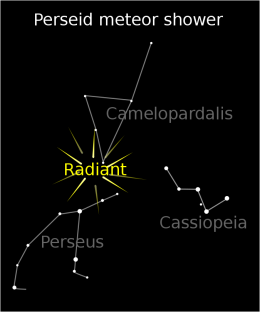![]()

The annual Perseid Meteor Shower is expected to peak the next 3 nights with 60 or more shooting stars visible per hour.
NASA calls the Perseids “one of the most plentiful showers,” making it easy to watch, weather permitting – and most of tonight there’ll be no moonlight to ruin the show.
Your best chance of catching a view of the shower is in the early morning hours, midnight to dawn, but it’s possible to see them as early as 10:00.
Give yourself at least an hour of observing time, if possible. That’s partly because it can take up to 20 minutes for your eyes to adjust and partly because meteor showers are a combination of spurts and lulls.
Try to be as comfortable as possible, like using a reclining lawn chair, and bring snacks and drinks – either hot or cold. A light blanket or jacket might handy depending on exactly where you are.
The Perseid meteor shower is named because they appear to come from the constellation Perseus the Hero.
They’re actual debris from Comet Swift-Tuttle entering Earth’s atmosphere as the planet travels through the comet’s orbit each year between July 17 and August 24
